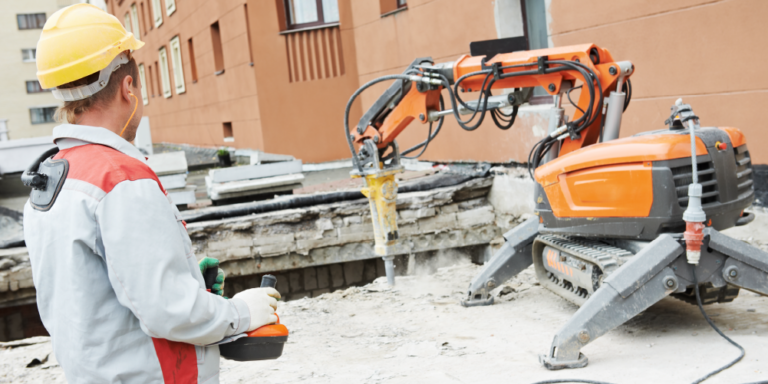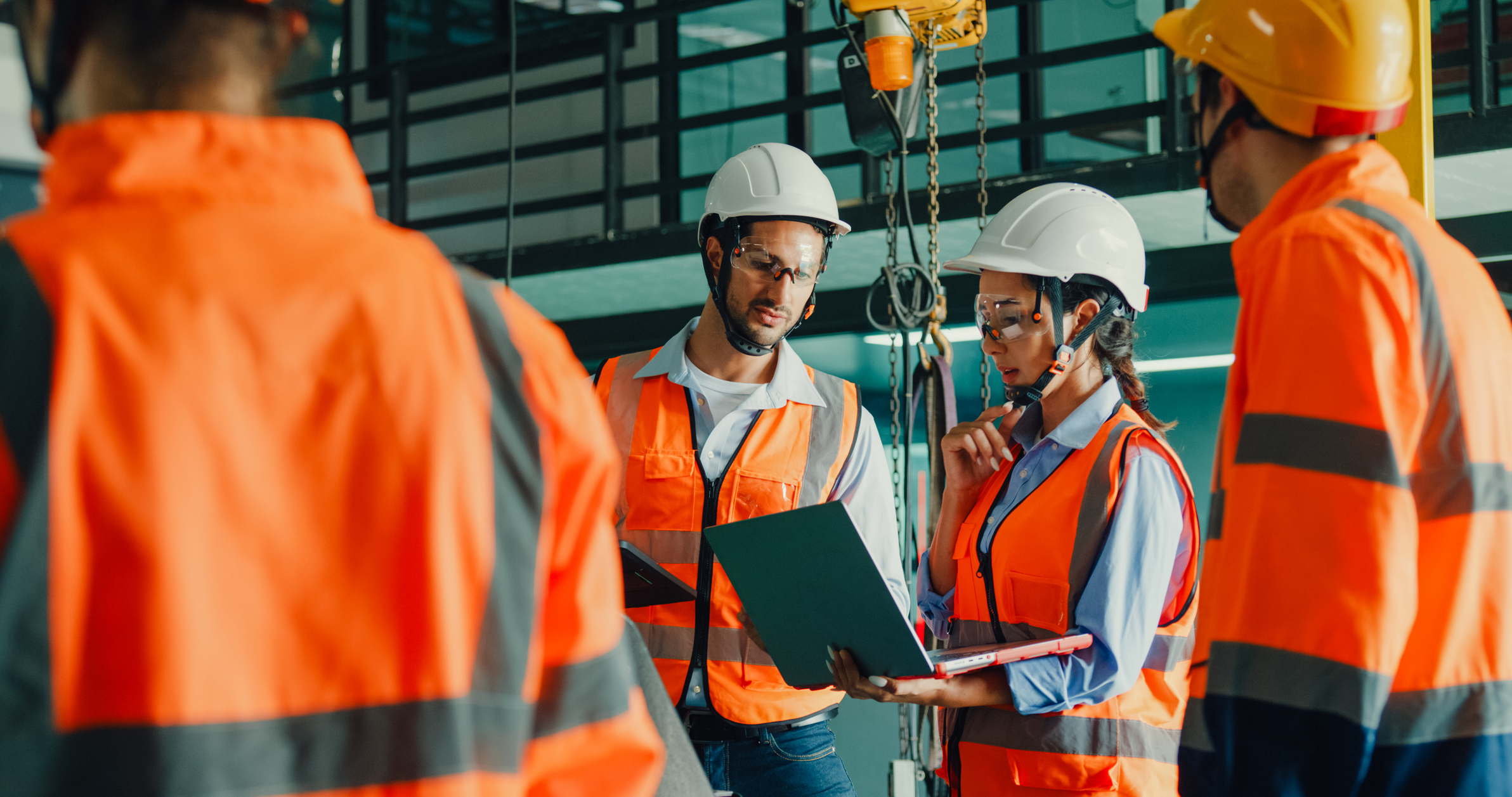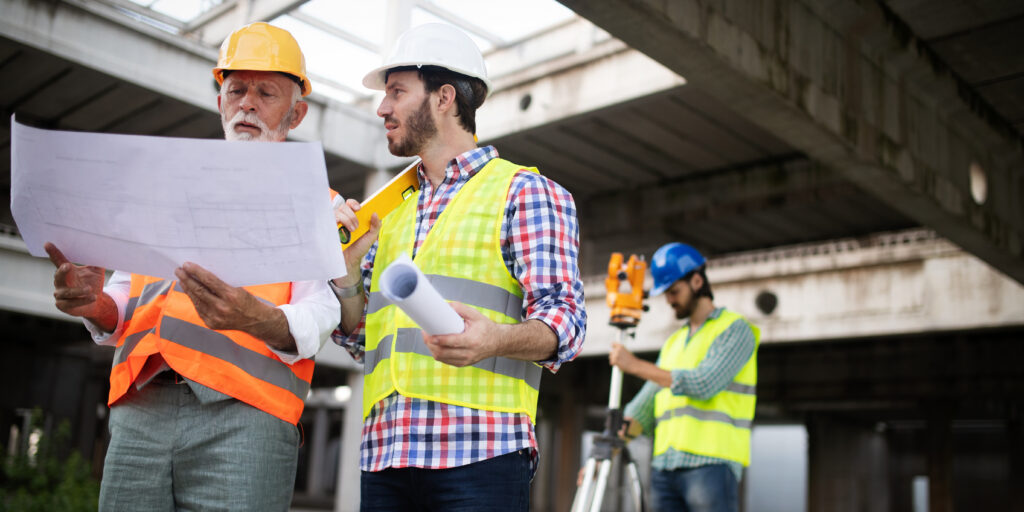— 7 min read
Robots Transform Construction: Building Smarter and Faster
Last Updated Mar 26, 2025
Last Updated Mar 26, 2025

Construction, one of the world’s most labour-intensive industries, is rapidly evolving as robots join the workforce. These machines bring enhanced safety, precision, and speed to building projects. From bricklaying and demolishing structures to autonomous equipment and 3D printing, robots are boosting productivity and efficiency on jobsites.
Unlike human workers, robots can handle repetitive, dangerous tasks more quickly and precisely, reducing mistakes and injuries. As UK construction companies face worker shortages and rising costs, many are turning to automation to simplify work and save money. To fully benefit from construction robotics, it’s essential to understand the types of robots, their real-world applications, benefits, challenges and future trends.
Table of contents
Robot Types in Construction
With safety and speed as top priorities on jobsites, robots now handle a growing range of tasks, making work safer, faster and more precise - transforming the construction industry. Here are the most commonly used construction robots:
Bricklaying Robots
These robots can lay thousands of bricks daily, working much faster than humans. They make this repetitive task more efficient by perfectly aligning bricks, reducing material waste and improving quality.
Demolition Robots
These remote-controlled machines safely and quickly demolish structures. They are particularly effective in tight spaces or dangerous areas where traditional methods would endanger workers.
Layout Robots
These robots map and print building plans directly onto surfaces, reducing mistakes during preparation work and improving accuracy. They also prevent strain injuries by eliminating the need for manual layout markings.
Cartesian Robots (Gantry Robots)
Primarily used for handling materials and prefabrication, these robots move on three axes to load, position, and assemble building parts precisely.
Self-Driving Construction Equipment
Guided by GPS and sensors, these machines handle digging, grading, and moving materials with minimal human intervention, boosting productivity on large projects.
Industrial Robots
These robotic arms work in off-site prefabrication and modular construction, assembling parts precisely and quickly, cutting labour costs and production time.
Shape the Future of the Built Environment at Procore's Construction Summit
Engage with construction leaders and discover the latest technology and best practices that are driving change across the industry.

Real Uses of Construction Robots Today
While robots once seemed futuristic, many types are already transforming construction sites worldwide. In the UK, robot-assisted prefabrication is growing rapidly, especially in modular housing projects addressing the housing shortage. From large infrastructure projects to precision manufacturing, here’s how builders are currently using robotics:
1. Bridge Building
Robotic welders and automated scaffolding expedite bridge construction while ensuring precision and strength. Drones inspect bridges, create maps and monitor structural health.
Major UK projects like HS2 and Crossrail could leverage robotics to enhance efficiency in tunnelling, steelwork, and assembly. Offshore wind farms can benefit from self-operating equipment and robotic welding for safer, more precise work.
2. High-Rise Construction
Skyscrapers require precision and speed. Robotic cranes and self-operating elevators reduce labour needs and improve safety in tall building projects. Robots streamline facade installation by handling glass panels and exterior fittings with millimetre accuracy.
3. Road Building and Infrastructure
Self-driving pavers and line-marking robots make motorways and urban roads more durable and efficient. They keep workers out of dangerous work zones while improving surface grading accuracy and material distribution.
4. Factory-Built Construction
Robots play a key role in off-site manufacturing, where factory-built components come together using robotic arms, cutting machines, and automated welders. This enables faster, precise building assembly with fewer on-site disruptions.
5. Digging and Earthmoving
Self-operating bulldozers, excavators, and trenching systems prepare sites, dig and level ground. These machines work with minimal human oversight, offering greater productivity and accuracy while reducing safety risks.
Benefits of Construction Robots
The construction industry faces growing pressure to improve efficiency, sustainability, and safety while controlling costs. Robots offer scalable solutions to these challenges, delivering significant benefits:
Better Safety
- Robots handle dangerous tasks like demolition, high-altitude work, and hazardous materials, improving risk management.
- Fewer worker injuries result in less downtime and lower insurance costs.
Higher Efficiency and Productivity
- Robots work faster and longer than human workers, speeding up project timelines.
- Automation eliminates bottlenecks, reducing delays in critical building phases.
Better Quality and Precision
- Robots deliver millimetre-accurate installations, reducing reworks.
- Factory production with robotic assistance improves consistency in modular construction.
Cost Savings
- Fewer delays and mistakes lead to lower labour and material costs over time.
- Long-term returns outweigh the upfront investment as automation improves site operations.
Less Material Waste
- Robotics systems use precise calculations to minimise excess materials, making projects greener and more cost-efficient.
Challenges in Using Construction Robots
While construction robots offer significant advantages, implementing them isn’t always straightforward. Here are the biggest challenges companies face when adopting robotic technologies:
High Startup Costs
The initial investment in robotic equipment, software, and training can be substantial. Many companies hesitate due to budget constraints and uncertain returns.
Skill Gaps and Worker Adaptation
Robotic systems require skilled operators and technicians, creating demand for specialised training. Existing workers may need new skills to work effectively alongside robots.
Rules and Compliance Issues
Construction sites follow strict safety and labour regulations, and robotic systems must meet evolving standards. In the UK, robotics must comply with HSE (Health and Safety Executive) regulations and the CDM (Construction Design and Management) Regulations 2015. Insurance and liability questions around automation remain unclear.
Site Adaptability and Real-World Use
Unlike controlled factory settings, construction sites can be unpredictable; robots typically require predictability and may struggle with constant changes. In the UK, wet and changing weather affects outdoor robots, particularly self-operating machinery on muddy or uneven ground, creating technical and logistical challenges.
Resistance to Change
Some construction firms remain cautious about replacing traditional methods with automation. Concerns about job loss and investment returns often slow adoption.
What’s Next for Construction Robots?
As technology advances, construction robots are becoming smarter, more independent, and better integrated with AI systems. Here’s what’s shaping the future:
AI-Powered Automation
- Machine learning and AI allow robots to make real-time decisions, reducing the need for human oversight.
- Predictive AI can spot potential site hazards and suggest better workflows, improving safety and efficiency.
Fully Self-Operating Jobsites
- Future construction sites may feature robotic machinery operating with minimal human intervention.
- Self-driving bulldozers, excavators, and trucks could work together, reducing downtime and speeding up projects.
3D Printing Growth
- Large robotic 3D printers are being tested to print entire buildings using sustainable materials.
- UK interest in 3D-printed housing is growing, with test projects addressing the housing shortage through cost-effective, quick-build homes.
Wearable Robots and Exoskeletons
- Robotic exoskeletons reduce strain on workers, increasing endurance and reducing fatigue.
- These devices let workers lift heavier materials with less injury risk, extending careers in physically demanding roles.
Green and Energy-Efficient Robots
- Eco-friendly robotic solutions reduce energy use and material waste.
- The UK’s net-zero carbon goals will likely increase the adoption of sustainable construction robots to minimise environmental impact.
Are Construction Robots Worth the Cost?
While construction robots offer clear benefits, the initial investment can deter some firms, leading many to question whether the return justifies implementation. Here’s how the returns might look:
Cost vs. Long-Term Savings
- Initial capital for equipment, software, and training is balanced by operational savings from reduced labour costs, fewer delays, and less material waste, offsetting expenses over time.
Faster Build Times and Productivity
- Robots work faster and longer than humans, shortening project timelines and cutting labour costs.
- Modular construction with robots can cut building time by up to 50%, offering quicker returns.
Fewer Mistakes and Less Rework
- Robotics increase accuracy, reducing costly rework from human error.
- In factory-built and modular construction, robotic precision eliminates material waste and design inconsistencies.
Competitive Edge and Growth
- Companies investing in robots early may gain advantages by bidding for larger, more complex projects.
- As UK construction faces worker shortages and sustainability pressures, robotics will likely become essential rather than optional.
When Robotics Investment Makes Sense
Robot investment may not work for all construction firms, especially smaller companies. Construction robotics benefit most:
- Large infrastructure projects (e.g., HS2, smart motorways, offshore wind farms)
- Companies involved in modular and factory-built construction
- Firms aiming to meet net-zero targets through automation and sustainable building
While construction robots are no longer purely futuristic, their full potential continues to develop. High costs, rapidly changing AI, skill shortages, and regulatory challenges remain, but the long-term benefits – faster builds, fewer errors, and lower costs – increasingly justify the initial investment.
As the UK construction industry tackles worker shortages and sustainability concerns, robots will play a major role in reshaping the sector. Companies embracing automation today position themselves to stay competitive in the years ahead.
Categories:
General Industry, Project Management, Resource Management, Tech and Data
Tags:
Written by
Nicholas Dunbar
29 articles
Nick Dunbar oversees the creation and management of UK and Ireland educational content at Procore. Previously, he worked as a sustainability writer at the Building Research Establishment and served as a sustainability consultant within the built environment sector. Nick holds degrees in industrial sustainability and environmental sciences and lives in Camden, London.
View profileExplore more helpful resources

Construction Document Software: Essential Tools for Project Success
Construction projects depend on extensive paperwork, including designs, contracts, RFIs, and compliance records. A single misplaced document can trigger delays, disputes, or compliance violations. Despite increasing digital adoption, many teams...

Construction Planning: A Guide to Successful Project Execution
Every successful construction project begins long before the first brick is laid. Indeed, behind each structure – whether a towering skyscraper or complex infrastructure project – lies a carefully crafted...

Leveraging Analytics for Better Financial Forecasting in Construction
Financial forecasting is a difficult task in any industry. In construction, where companies need to manage volatile material costs, labour shortages and variation orders on a daily basis, fluctuations in...

Strategies to Prevent Rework: The Importance of Clear Instructions
In construction, “rework” is the dreaded process of redoing tasks due to mistakes, quality issues, or safety concerns. This unnecessary work drains budgets through wasted materials and labour while causing...